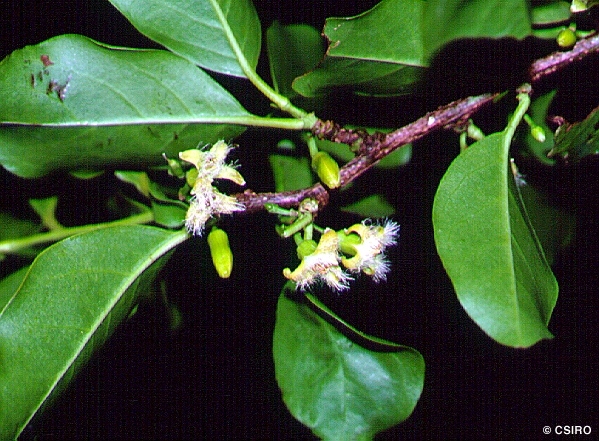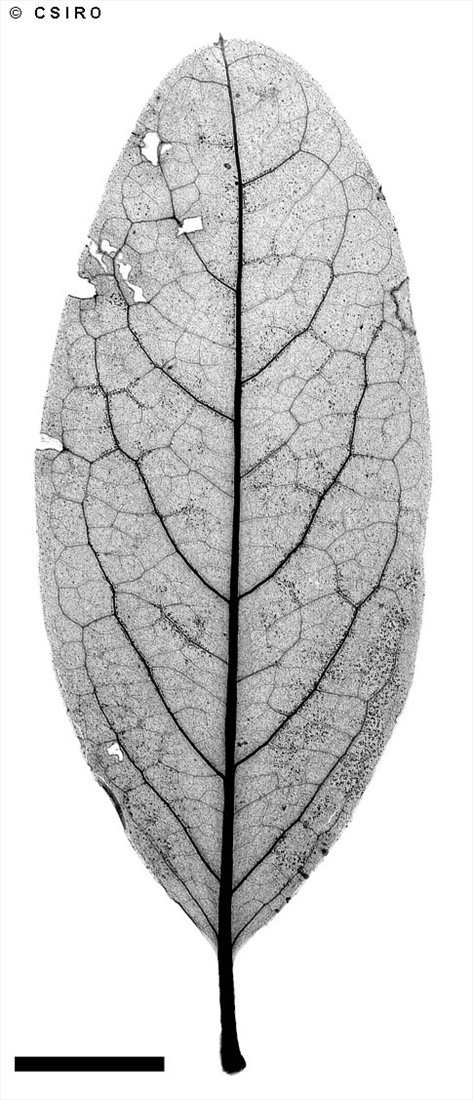Australian Tropical Rainforest Plants - Online edition
Ximenia americana L.




Linnaeus, C. von (1753) Species Plantarum 2: 1193. Type: Tropical America, collector unknown; lecto: BM (Hort. Cliff. 483) Fide G. Ll. Lucas, Fl. Trop. E. Africa, Olacaceae: 5 (1968).
Plum, Yellow; Tallow Wood; Yellow Plum
Usually grows as a scrambly vine or weak shrub about 1-5 m tall.
Twigs with numerous pale coloured lenticels and longitudinal ribs, sometimes with a few short straight spines. On older twigs, the leaves are produced in a tight spiral on short lateral burr-like structures. Leaf blades about 3.5-7.5 x 2-3.8 cm, soft when fresh but very brittle when dry, cracking and breaking along lines either parallel to or at right angles to the midrib with no sign of stringy vascular tissue. Apex of the leaf blade retuse with a gland in the V on the underside.
Calyx about 0.5-1.5 mm long. Corolla about 7-10 mm long, densely bearded on the inner surface. Petals recurved at or following anthesis. Anther filaments about 2.5-4 mm long, sigmoid near the apex, anthers about 2-4 mm long, connective apiculate. Ovary conical or pyriform. Styles filiform, about 2.5-5 mm long.
Fruits subglobose, ellipsoid or ovoid, about 17-25 x 15-30 mm. Endocarp bony. Embryo quite small, surrounded by endosperm. Cotyledons about as wide as the radicle.
Cataphylls about 5 or 6 or more before the first true leaf is produced. At the tenth leaf stage: seedling completely glabrous, leaf blade elliptic, apex aristate, base cuneate, oil dots present only along the margin of the leaf blade. Stem conspicuously ribbed with two ribs decurrent from each petiole. Seed germination time 64 to 331 days.
Occurs in NT, CYP, NEQ and CEQ. Altitudinal range from near sea level to 200 m. Grows in open forest but most frequently encountered in various types of closed forest close to the sea. Also occurs in tropical regions in the rest of the world.
May be parasitic on the roots of other plants.
This species produces yellow succulent fruits which some people believe are rich in vitamin C. Unfortunately, the plant is rich in a cyanogenetic glycoside so that the leaves are probably poisonous to stock at any time of the year when eaten in sufficient quantity. People who eat the fruit may be taking a significant risk. Everist (1974).
This species was found to be toxic to the Golden Snail in South East Asia. (http://www.wda.co.uk/business/publns/advances/iss ues/issue17/agri01.htm).
This species may have medicinal properties and it is also poisonous. (http://squid2.laughingsquid.net/hosts/herbweb.com /herbage/A28378.htm)





